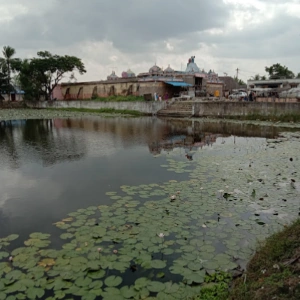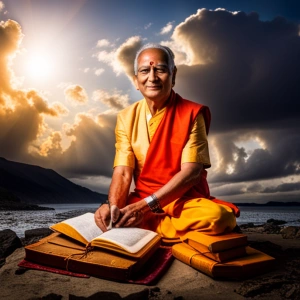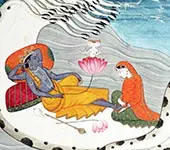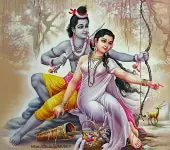Horse Sacrifice Ritual In Dasharatha's Yaga
Discover the fascinating details in the horse sacrifice ritual in Dasharatha's Yaga
Quiz
During Sri Rama's exile, which was the capital of Kosala kingdom ?Transcript
(Click here to read more)
Ashwamedha yaga involves animal sacrifice. Justifying animal sacrifice in yaga is a very elaborate task. We will not be able to do this now. Only one thing I will point out here. Yaga is called adwhara - adhwara means non-violent. Even if animal sacrifice is there , yaga is specifically marked up as non-violent, prompting us to enquire deeper into this to find the facts. Killing animals during yaga is not killing. This is a very primary Vedic principle. Animals are sacrificed not for eating. The sacrifice is not even for just sati....
Transcript
(Click here)
Ashwamedha yaga involves animal sacrifice.
Justifying animal sacrifice in yaga is a very elaborate task.
We will not be able to do this now.
Only one thing I will point out here.
Yaga is called adwhara - adhwara means non-violent.
Even if animal sacrifice is there , yaga is specifically marked up as non-violent, prompting us to enquire deeper into this to find the facts.
Killing animals during yaga is not killing.
This is a very primary Vedic principle.
Animals are sacrificed not for eating.
The sacrifice is not even for just satisfying the Devas.
Very very deep principles are learned from animal sacrifice.
Here, in Dasharatha's Ashwamedha yaga, now arrangements are being made for animal sacrifice.
300 animals are sacrificed during Ashwamedha and of course the horse.
Valmiki calls the horse अश्वरत्नोत्तमम्, the gem among them.
Twenty one pillars were erected onto which the animals are tied.
Everything has specifications.
With utmost precision it is to be done.
Shulba sutra governs the architectural side of this.
Out of the twenty one pillars called yupas, six are made of Bilwa tree, six of Khadira tree, six of Palasha tree, two of Devadaru and one of a tree called श्लेष्मातक.
Even their placement is specified.
Shleshmataka at the center.
On its either side, Devadaru.
On the left of this three yupas of Bilwa, to the right the other three Bilwa yupas.
Again to the left, three yupas of Khadira.same to the right also.
After this Palasha, three each on either side.
The order has to be maintained.
You can't place Palasha between Bilwa and Khadira.
Each yupa should be twenty one aratni in height.
We have seen how much is an aratni - चतुर्विंशत्यङ्गुलयोरत्निः
Roughly one and a half feet is one aratni.
So twenty one aratni means roughly 31.5 feet in height.
They are all covered with golden plates and polished, decorated with clothes.
They were all worshiped with chandana and flowers and they stood in the yaga vedi as brilliant the Saptarshi stars in the sky.
Then the vedi of Agni chayana was there, carefully constructed with bricks of specified measurements in the form of a gaurda.
A garuda with its wings and tail spread, facing east and looking down.
Its wings were made of gold.
This is a body or vehicle for the yajamana to travel towards immortality.
All kinds of animals, even snakes and birds are brought to the yagavedi, domestic and wild.
Out of these, only the domestic are tied to the yupas and sacrificed.
The wild are set free after they are circumambulated with Agni thus symbolically sacrificing them.
This is called paryagni.
There are many citations saying that it was Kausalya who sacrificed the horse.
They even quote this verse from Valmiki Ramayana for this.
कौसल्या तं हयं तत्र परिचर्य समन्ततः ।
कृपाणैर्विशशासैनं त्रिभिः परमया मुदा ॥
This is because they don't understand the yaga procedure.
The horse is already sacrificed.
Kausalya stays awake throughout the night doing paricharya of the horse.
It involves circumambulating its body, clockwise, then anticlock wise, beating the thighs, like how it is done during the death rites.
Then she marks with three needles made of gold, the lines through which the body of the horse should be cut to pieces and offered in Agni.
She didn't kill the horse with three strokes of the sword.
That's not her role.
In yagas involving animal sacrifice, the animal is killed by choking, not by cutting its neck with a knife or sword or whatever.
Throughout the night, she has to stay physically in touch with the body of the horse.
She approaches the horse chanting the mantra - अंबे अंबाल्यंबिके.
She has to do abhimantranam of the body of the horse with the mantra - गणानां त्वा गणपतिं हवामहे.
Then throughout the night she stays touching the horse.
There is mantra for this - उत्सक्थ्योर्गृदं धेहि.
The Adhwaryu purohita covers both the mahishi, mahishi means the primary queen, which is Kausalya in this case.
He covers both of them together with a cloth made of silk, chanting - सुभगे कांपीलवासिनि.
See how much goes into this.
Animal sacrifice in yaga is not just cutting and offering in fire.
All the purohitas, the yajamana, Dasharatha, they all have to stay awake throughout the night.
Recommended for you
Pongu Sani Temple, Thirukollikadu

Discover the unique temple in Tamil Nadu where Saneeswaran knows only to bless and not to punish....
Click here to know more..Vedas - Holy Books Of Hinduism

All the four Vedas in PDF format translated into English....
Click here to know more..Venkatesha Bhujanga Stotram

vibhum taapasam sachchidaanandaroopam dharantam muraarim bhaje venkat'esham. shriyaa visht'itam vaamapakshaprakaasham surairvanditam brahmarudrastutam....
Click here to know more..
English Topics
Ramayana
Click on any topic to open
- 50 Janaka's Spiritual Evolution - From Jnana to Bhakti
- 49 Dasharatha's Grief Decoded
- 48 Shiva burned Kamadeva at Chhapra, Bihar
- 47 Motherhood brilliance - Kausalya Supraja Rama
- 46 Bala and Atibala Mantras - Sriram Ji will unfold their superpower
- 45 Dasharatha Pleads With Vishwamtra Not To Take Away Young Sriram Ji
- 44 Abandoning Of Sita Devi - Is It Justifiable?
- 43 Vishwamitra Wants To Take Young Sriram Ji With Him
- 42 Position Of Sages In Ancient Bharata
- 41 Horoscope of Sriram Ji
Please wait while the audio list loads..
30
Ganapathy
Shiva
Hanuman
Devi
Vishnu Sahasranama
Mahabharatam
Practical Wisdom
Yoga Vasishta
Vedas
Rituals
Rare Topics
Devi Mahatmyam
Glory of Venkatesha
Shani Mahatmya
Story of Sri Yantra
Rudram Explained
Atharva Sheersha
Sri Suktam
Kathopanishad
Ramayana
Mystique
Mantra Shastra
Bharat Matha
Bhagavatam
Astrology
Temples
Spiritual books
Purana Stories
Festivals
Sages and Saints
